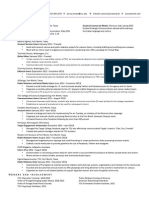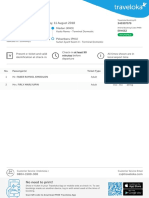TCU Wind Initiative
TCU Wind Initiative
Uploaded by
JennaSimardCopyright:
Available Formats
TCU Wind Initiative
TCU Wind Initiative
Uploaded by
JennaSimardCopyright
Available Formats
Share this document
Did you find this document useful?
Is this content inappropriate?
Copyright:
Available Formats
TCU Wind Initiative
TCU Wind Initiative
Uploaded by
JennaSimardCopyright:
Available Formats
TCU College of Science & Engineering
7/26/13 7:38 PM
HOME | Donate | Office of the Dean | Media
Prospective Students
Undergraduate Students
Graduate Students
Academics
Research
Faculty
Alumni
A powerful wind
By Jenna Simard, CSE communications intern Wind power: the worlds fastest source of renewable energy. With growth of 25 to 50 percent each year over the past five years, the rapidly expanding industry currently supplies nearly 2.5 percent of annual electricity consumption in America. As concern over climate change and the high cost of fossil fuels has increased over the past several decades, researchers have recognized wind power as a viable solution to the energy crisis. The relatively benign resource produces zero waste, causes no harmful pollutants and requires minimal cost. That is not to say, however, that it is without concerns. Researchers are now studying wind powers overall impact on the environmentand leading the exploration are members of the TCU community. Established in 2008, the TCU Wind Initiative unites TCU and NextEra Energy Resources, the number one generator of solar and wind power in North America, to research wind power as it relates to environmental and social issues. The project runs through 2016 and aims to analyze the resource through researching three core areas: winds ecological footprint, its socio- Kalyssa Pollard (L), undergraduate student, and Jenny Korstian, graduate student) had economic impact and its relationship to carbon and just completed a fatality search at a wind climate. turbine and are getting ready to collect data on the dead bat they found (in front of their Michael Slattery, professor and director of the Institute for Environmental Studies and the initiatives feet). lead scientist, said the wind energy industry will benefit from the teams research. If we believe in renewable energy sources, we must know how to use them wisely, said Slattery. We must exploit these renewable resources but acknowledge the impact of doing so.
Ecological Impact
One objective of the initiative involves evaluating the effect of wind on wildlife. Led by assistant professor of biology Amanda Hale, the ecological team addresses environmentalists concern of the threat turbines pose on bird and bat populations. The growth of the Bats and Wind Energy Cooperative (BWEC) and development of the wind industry, especially in Texas, led Hale to commence research in 2008. Texas has more installed wind than any other state, but at the time there was no research on the impact on Texas wildlife, she said. Over the past five years the team has conducted field studies at Wolf Ridge Wind Energy Center in Cooke County, Texas, to monitor bird and bat mortality. The team also compares bird and bat activity at the facility to that of nearby control sites to determine the impact of wind farms on these species. In their first year of research, the team discovered thousands of dead bats on site. We want to determine how we can stop this from happening, Hale said. The team uses out-of-the-box methods to study bat mortality, including using an extensive molecular method to genetically barcode bats. Hale and her team are working with NextEra to determine how to use their research to reduce the ecological impact of wind energy.
http://www.cse.tcu.edu/newsletter/2013-summer-Wind.asp
Page 1 of 3
TCU College of Science & Engineering
7/26/13 7:38 PM
Socioeconomic Impact
A second objective of the initiative is producing meaningful data to be used for growth of the industry. Researchers in the socio-economic team, led by Becky Johnson, professor of Professional Practice, have developed a cross-sectional study to observe the influence of wind farms on ecosystems and local economies. The teams ultimate goal is to generate a strategy for presenting wind energy and determine the best way to communicate the benefits of wind farms for local communities. Johnsons team began research in 2008 in the rural west Texas counties of Coke and Sterling, where wind was the primary source of economic momentum. The group has since expanded its study to other rural areas in Texas and throughout the nations wind corridor, including Kansas, Iowa and Oklahoma, and has partnered with universities to collaborate in regional research. By collecting county-specific information and gathering local economic figures over time, the team has been able to observe the impact of wind farms on these areas. Johnson said that, while the level of impact varies for any given area, the wind industry usually has the largest effect on smaller, more rural economies.
The initiative also focuses on wind farms psychological impact on communities. Johnson and her team distribute surveys to a random sample of individuals in each area to study environmental attitudes and gauge public perception on the impact of wind farms. Public opinion has been mostly positive, especially after the construction phase, said Johnson. There are generally high approval ratings, regardless of individuals proximity to wind farms. Johnson said she and her team plan to continue analyzing other areas throughout the wind corridor, and possibly expand research to Canada.
Graduate student Aaron McAlexander is setting up the playback experiment equipment at a cattle pond in the wind farm. This allows researchers to see what bat echolocation calls look like when they are reflected from water so they can compare them to echoes from wind turbine towers.
Climate and Carbon
Matthias Fripp of Oxford University currently leads the initiatives third area of focus. Fripp has worked with TCU and NextEra to research low-impact methods of sustaining wind energy. He and his team have introduced a model for estimating the uncertainty of wind power forecasts. Despite that wind farms provide electricity without producing harmful emissions, fossil-fired generators may be required to provide power when wind is unexpectedly low. Thus, Fripp uses a model to determine the generation capacity and spinning reserves required to sustain wind power structures. Ultimately, the Oxford team seeks to determine how wind can most efficiently integrate into the energy grid. Slattery said he is unaware of any project that discusses issues of such expansive scope and special scale. Researchers involved have published 50 papers so far, and in the next six months will publish 20 more. Slattery and other team members have traveled to locations around the world to present the initiatives findings and have worked with regional governmental organizations to influence legislation, thereby offering TCU the opportunity to impact regulation and, as a result, gain visibility among other researchfocused institutions. Its gratifying to put TCU on the map, Slattery said. Johnson echoes Slatterys reaction to the initiatives success, the product of what she said is the largest single research grant TCU has ever received. A research grant of this magnitude on an issue of this importance speaks volumes, she said. People in the wind industry know of TCU now. Furthermore, the initiative gives students the opportunity to engage in meaningful research and learn alongside experienced scientists. Graduate and undergraduate students involved with Hales ecological
http://www.cse.tcu.edu/newsletter/2013-summer-Wind.asp Page 2 of 3
TCU College of Science & Engineering
7/26/13 7:38 PM
alongside experienced scientists. Graduate and undergraduate students involved with Hales ecological team partake in field studies, thereby contributing to on-site research with faculty and technicians. In addition, students participate in analyzing data and presenting at conferences around the country. Some have gone on to earn masters degrees related to their work. Slattery said that, ultimately, seeing students engaged in the research is one of the projects most significant successes. (For more information about the TCU Wind Initiative, visit www.wind.tcu.edu.)
Departments & Programs
Biology Chemistry Computer Science Engineering Mathematics Nutritional Sciences Physics and Astronomy Pre-Health Professions Psychology School of Geology, Energy & The Environment
Institutes & Centers
Institute of Child Development Institute for Environmental Studies Center for GIS and Remote Sensing Center for Applied Psychology
Science and Engineering Research Center
Student Research Symposium TCU IdeaFactory Monnig Meteorite Gallery Institute of Behavioral Research Energy Institute
2011 Texas Christian University | College of Science & Engineering Suite 102 Tucker Technology Center | TCU Box 298960 | Fort Worth, TX 76129 | Phone: 817.257.7727 | Fax: 817.257.7736
http://www.cse.tcu.edu/newsletter/2013-summer-Wind.asp
Page 3 of 3
You might also like
- Open Science Hardware: A Shared Solution To Environmental Monitoring ChallengesDocument29 pagesOpen Science Hardware: A Shared Solution To Environmental Monitoring ChallengesThe Wilson CenterNo ratings yet
- Social Media Addiction Research IDocument27 pagesSocial Media Addiction Research IJennaSimard77% (13)
- Science 2801Document140 pagesScience 2801Rogério Caiado MachadoNo ratings yet
- KomunikasyonDocument15 pagesKomunikasyonJohn ClementeNo ratings yet
- The Power of Solar EnergyDocument11 pagesThe Power of Solar Energyapi-317733481No ratings yet
- 2006 Major Sponsored Program and Faculty Awards For Research & Creative ActivityDocument43 pages2006 Major Sponsored Program and Faculty Awards For Research & Creative ActivitybuythishornNo ratings yet
- Remote Sensing: of Climate DataDocument63 pagesRemote Sensing: of Climate Dataciehaha1No ratings yet
- Cód FlorestalBrasilScience2010 - 276 - 7Document3 pagesCód FlorestalBrasilScience2010 - 276 - 7oseias11No ratings yet
- University of Arizona College of Engineering Research Progress Report 2011Document16 pagesUniversity of Arizona College of Engineering Research Progress Report 2011UA College of Engineering100% (1)
- UTA Engineer 2012Document15 pagesUTA Engineer 2012UT Arlington College of Engineering100% (1)
- Research Proposal Naga Panchumarty Independent Research G/T 2016-2017 Title: Solar Energy in America Introduction and Overview of ResearchDocument3 pagesResearch Proposal Naga Panchumarty Independent Research G/T 2016-2017 Title: Solar Energy in America Introduction and Overview of Researchapi-345333980No ratings yet
- GSOE Research News 2018-19Document8 pagesGSOE Research News 2018-19CCNY CommunicationsNo ratings yet
- And Evaluate Two Methods of Addressing Plastic Pollution at National And/or Local Government LevelDocument7 pagesAnd Evaluate Two Methods of Addressing Plastic Pollution at National And/or Local Government LevelAaqibali LudhianviNo ratings yet
- Michael Chapter 2 - 110013Document21 pagesMichael Chapter 2 - 110013jerry simonNo ratings yet
- Environment: Center For TheDocument7 pagesEnvironment: Center For Thegiya_947529No ratings yet
- Data Mining 1ACDocument37 pagesData Mining 1ACsunny993No ratings yet
- Rethinking PowerDocument3 pagesRethinking PowerstanscimagNo ratings yet
- RRL ChlaireDocument3 pagesRRL ChlaireJoshua IloretaNo ratings yet
- Impact of Nuclear Energy On The EnvironmentDocument17 pagesImpact of Nuclear Energy On The EnvironmentdeikyarizalNo ratings yet
- Literature Review On Environmental IssuesDocument4 pagesLiterature Review On Environmental Issuesc5t6h1q5100% (1)
- EPA Science - Casualty of Election PoliticsDocument5 pagesEPA Science - Casualty of Election PoliticsscriberoneNo ratings yet
- A Critical Review of Theoretical Models For Estimating Global Solar Radiation Between 2012-2016 in NigeriaDocument20 pagesA Critical Review of Theoretical Models For Estimating Global Solar Radiation Between 2012-2016 in NigeriasamuelNo ratings yet
- Current Issues in Environmental Management in Australia: What Do People Think?Document21 pagesCurrent Issues in Environmental Management in Australia: What Do People Think?Mahwestie PwarnasoekmaNo ratings yet
- Emerging Opportunities and Challenges in Phenology A Review - 2016 - Tang Et AlDocument17 pagesEmerging Opportunities and Challenges in Phenology A Review - 2016 - Tang Et AlTony AlmeidaNo ratings yet
- The 2012 ECE CommunicatorDocument12 pagesThe 2012 ECE CommunicatorElectrical and Computer Engineering (ECE) at the University of Utah100% (1)
- Root,+journal+manager,+70 IJEEP 10400 Qazi112Document8 pagesRoot,+journal+manager,+70 IJEEP 10400 Qazi112tuananh9a7lhpqnNo ratings yet
- RSCH - Awards Booklet - FRF11Document118 pagesRSCH - Awards Booklet - FRF11buythishornNo ratings yet
- RSCH 2005 BookDocument72 pagesRSCH 2005 BookbuythishornNo ratings yet
- ScienceDocument11 pagesScienceannygiron2007No ratings yet
- Topic Proposal Group 8Document11 pagesTopic Proposal Group 8semesporlasNo ratings yet
- Environmental Impacts Using Solar Panels 1Document31 pagesEnvironmental Impacts Using Solar Panels 1glodycar DiazNo ratings yet
- Fukushima Health Study LaunchedDocument2 pagesFukushima Health Study Launchedcentaurus553587No ratings yet
- Rebutting 33 False Claims About Solar Wind and Electric VehicleDocument66 pagesRebutting 33 False Claims About Solar Wind and Electric Vehiclezx1195065345No ratings yet
- Summarize ExamplesDocument3 pagesSummarize ExamplesBerfin CagilNo ratings yet
- Literature Review On Environmental DegradationDocument8 pagesLiterature Review On Environmental Degradationafmzaoahmicfxg100% (1)
- Fsu Labs2Document4 pagesFsu Labs2api-301986221No ratings yet
- Sovacool - Integrating Social Science in Energy ResearchDocument5 pagesSovacool - Integrating Social Science in Energy ResearchEmilio Nudelman CruzNo ratings yet
- Melissa Gascot, Alec Greider, Artur Izoita, Michael Ho, Mark IzevbigieDocument21 pagesMelissa Gascot, Alec Greider, Artur Izoita, Michael Ho, Mark Izevbigiemgascot1449No ratings yet
- ISC GuideDocument4 pagesISC GuidenamratamangalNo ratings yet
- Exploring Scientific Inquiry and AdvancesDocument9 pagesExploring Scientific Inquiry and Advancesmofegid228No ratings yet
- Print KarunDocument7 pagesPrint Karunjenavner0No ratings yet
- 2008 AwardsBooklet FINALDocument100 pages2008 AwardsBooklet FINALbuythishornNo ratings yet
- Articulo 2Document9 pagesArticulo 2fernandoNo ratings yet
- Literature Review Vs Environmental ScanDocument6 pagesLiterature Review Vs Environmental Scanf0typiwydeb3100% (1)
- ENGLISHDocument24 pagesENGLISHkp99364No ratings yet
- The Role of Science and Technology in Future DesignDocument7 pagesThe Role of Science and Technology in Future DesignTeh Choon SiangNo ratings yet
- Student Annotated Bibliography 4Document3 pagesStudent Annotated Bibliography 4Mariane CanorioNo ratings yet
- PECS Spring 2008Document5 pagesPECS Spring 2008Princeton Environmental InstituteNo ratings yet
- Physics in A New EraDocument203 pagesPhysics in A New Eraedlira.shabani2No ratings yet
- 1 s2.0 S1462901119301133 MainDocument9 pages1 s2.0 S1462901119301133 Mainchanchunsumbrian100% (1)
- 2012 Arctic Meltdown EditionDocument40 pages2012 Arctic Meltdown EditionCIRESatCUNo ratings yet
- Energy Law Literature ReviewDocument6 pagesEnergy Law Literature ReviewPranav BhansaliNo ratings yet
- Wsu Honors College ThesisDocument8 pagesWsu Honors College Thesisashleyjeanwarren100% (2)
- Envi LawDocument8 pagesEnvi Lawbsl223034No ratings yet
- Investigate The Use of Solar Energy Into Small Houses For Sustainable LivingDocument27 pagesInvestigate The Use of Solar Energy Into Small Houses For Sustainable LivingChristianLouisNoquisNo ratings yet
- Sciadv Aax0903Document14 pagesSciadv Aax0903vicnted1No ratings yet
- Creative TensionsDocument2 pagesCreative TensionsHangbo YueNo ratings yet
- What's The Annual Value of Trees? $500 Million Per Megacity, Study SaysDocument11 pagesWhat's The Annual Value of Trees? $500 Million Per Megacity, Study SaysLuke SueNo ratings yet
- 5G - Scientific EvidenceDocument8 pages5G - Scientific EvidenceRosa AzulNo ratings yet
- Critical Risk Research: Practices, Politics and EthicsFrom EverandCritical Risk Research: Practices, Politics and EthicsStuart LaneNo ratings yet
- United Way InternalDocument3 pagesUnited Way InternalJennaSimardNo ratings yet
- TCU IdeaFactoryDocument2 pagesTCU IdeaFactoryJennaSimardNo ratings yet
- Enna Imard: John V. Roach Honors CollegeDocument1 pageEnna Imard: John V. Roach Honors CollegeJennaSimardNo ratings yet
- Chem ClubDocument2 pagesChem ClubJennaSimardNo ratings yet
- Prospective Students Undergraduate Students Graduate Students Academics Research Faculty AlumniDocument2 pagesProspective Students Undergraduate Students Graduate Students Academics Research Faculty AlumniJennaSimardNo ratings yet
- Social Media Addiction Research IIDocument35 pagesSocial Media Addiction Research IIJennaSimard100% (1)
- Hidden Gem: The Oscar E. Monnig Meteorite Gallery Celebrates 10 YearsDocument2 pagesHidden Gem: The Oscar E. Monnig Meteorite Gallery Celebrates 10 YearsJennaSimardNo ratings yet
- Elephant OutdoorDocument1 pageElephant OutdoorJennaSimardNo ratings yet
- GROW Campaign: Print Ad 2Document1 pageGROW Campaign: Print Ad 2JennaSimardNo ratings yet
- Twitter Analysis: SFMOMA & MoMADocument36 pagesTwitter Analysis: SFMOMA & MoMAJennaSimardNo ratings yet
- GROW Campaign: Print Ad 1Document1 pageGROW Campaign: Print Ad 1JennaSimardNo ratings yet
- ASSIGNMENTDocument3 pagesASSIGNMENTkanakrn.67No ratings yet
- Definition of SupplyDocument5 pagesDefinition of Supply백송희No ratings yet
- Question of Turbine Nozzle Force & MomentDocument3 pagesQuestion of Turbine Nozzle Force & MomentTon PhichitNo ratings yet
- Ent ProjectDocument3 pagesEnt ProjectreemNo ratings yet
- Ille-Salah 2020 MigrationDocument14 pagesIlle-Salah 2020 MigrationenricoilleNo ratings yet
- Gec - Political Science Assignment Topic - What Is Living and What Is Dead in AmbedkarDocument10 pagesGec - Political Science Assignment Topic - What Is Living and What Is Dead in AmbedkarSimone SidasowNo ratings yet
- Listen To Adele's Song "Someone Like You". Try To Identify The Main Topic of The Song. 2. Now Listen To The Song Again and Answer The BlanksDocument3 pagesListen To Adele's Song "Someone Like You". Try To Identify The Main Topic of The Song. 2. Now Listen To The Song Again and Answer The BlanksFrank OtkNo ratings yet
- Resume MonikaDocument4 pagesResume Monikamonika upadhyayNo ratings yet
- Genie GS-1930 Parts ManualDocument194 pagesGenie GS-1930 Parts ManualNestor Matos García100% (1)
- COMMUNITYDocument4 pagesCOMMUNITYAyesha KhalidNo ratings yet
- Brand Management Report 2Document33 pagesBrand Management Report 2bakhtawar soniaNo ratings yet
- Configuring Samba On DebianDocument3 pagesConfiguring Samba On DebianandaktdenNo ratings yet
- Mohammad Mansour Term ProjectDocument9 pagesMohammad Mansour Term ProjectMohamad MansourNo ratings yet
- 07.09 Midnight PrayerDocument8 pages07.09 Midnight PrayerFungai DirikweNo ratings yet
- H R StaffingDocument6 pagesH R StaffingIrwan M. IskoberNo ratings yet
- Predictive Data Mining and Discovering Hidden Values of Data WarehouseDocument5 pagesPredictive Data Mining and Discovering Hidden Values of Data WarehouseLangit Merah Di SelatanNo ratings yet
- GST Charged DetailsDocument3 pagesGST Charged DetailsGaurav KNo ratings yet
- Igbt Irg 4p254sDocument9 pagesIgbt Irg 4p254sMilagros Mendieta VegaNo ratings yet
- VPS-300P Video Production SystemDocument1 pageVPS-300P Video Production SystemjamesNo ratings yet
- Critical Water Activity of Disaccharide-Maltodextrin BlendsDocument6 pagesCritical Water Activity of Disaccharide-Maltodextrin Blendspruebas123123No ratings yet
- Bibl 301 Intermediate Greek 1-Course OutlineDocument3 pagesBibl 301 Intermediate Greek 1-Course Outlinemuntanga shaftNo ratings yet
- Tutorial 2 DUW10022Document4 pagesTutorial 2 DUW10022Myhammad IshranNo ratings yet
- Components of Service MarketingDocument12 pagesComponents of Service MarketingManuj TripathiNo ratings yet
- METSEPM5350: Product Data SheetDocument2 pagesMETSEPM5350: Product Data SheetKuncoroNuryantoNo ratings yet
- HR Data CollectionDocument4 pagesHR Data CollectiontaghreedNo ratings yet
- Firly Marlyupin-KNO-E9Y65Z-PKU-FLIGHT - ORIGINATING PDFDocument2 pagesFirly Marlyupin-KNO-E9Y65Z-PKU-FLIGHT - ORIGINATING PDFMarisa TobingNo ratings yet
- Simulation of The Thermomechanical and M PDFDocument10 pagesSimulation of The Thermomechanical and M PDFIsmail DriouchNo ratings yet
- Technical WritingDocument10 pagesTechnical WritingMuhammad Youneeb100% (1)
- Admission Prospectus 2021Document23 pagesAdmission Prospectus 2021SAURABH YadavNo ratings yet
- Room Temperature Controllers With LCD: For Heating SystemsDocument8 pagesRoom Temperature Controllers With LCD: For Heating SystemsTrifonas KrommidasNo ratings yet





































































































